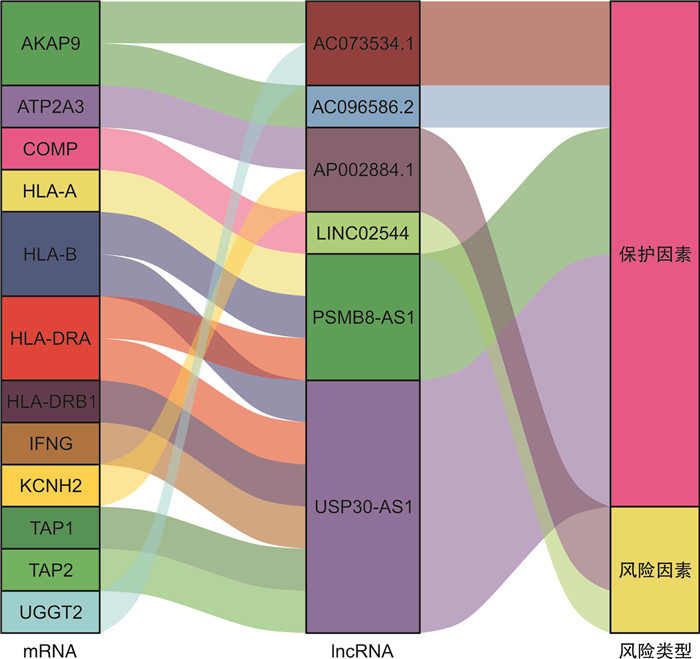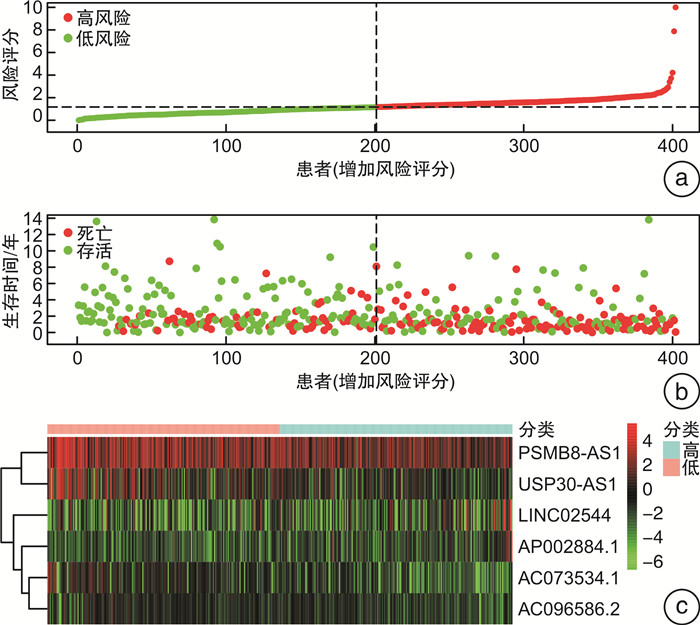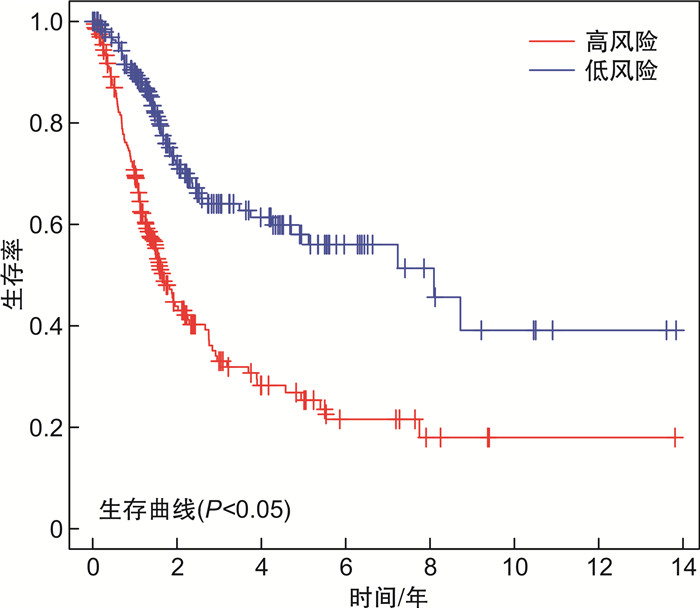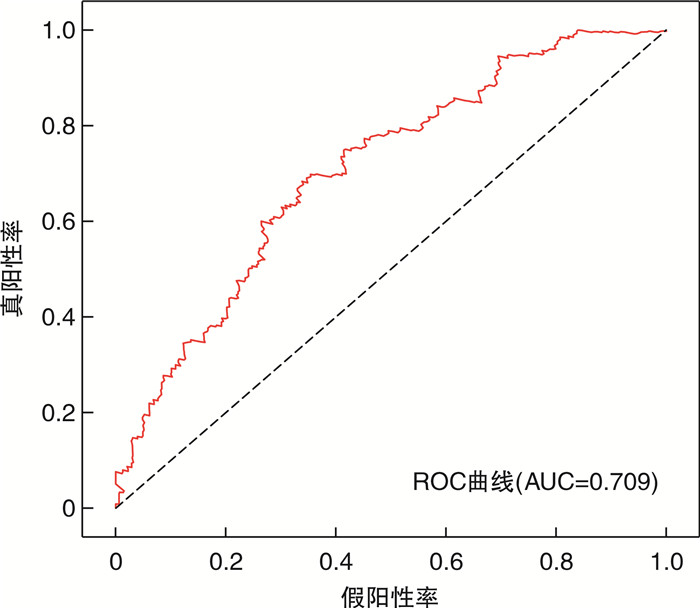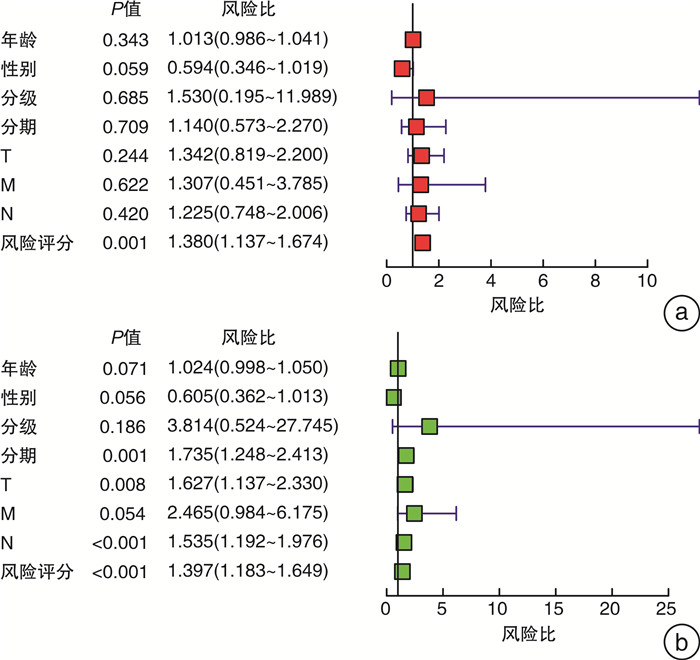Construction and analysis of a prognostic risk model for endoplasmic reticulum stress-related LncRNA in bladder urothelial carcinoma
-
摘要: 目的 此项研究旨在深度解析内质网应激相关长非编码RNA(long noncoding RNA,LncRNA)对膀胱尿路上皮癌(bladder urothelial carcinoma,BLCA)的预后效应,同时构建BLCA内质网应激相关LncRNA预后风险模型,以便更好地指导膀胱癌的个体化治疗。方法 从TCGA数据库中下载BLCA RNA测序数据和临床信息,在Genecard数据库中提取内质网应激相关基因列表,并采用Pearson相关性分析筛选出BLCA内质网应激相关LncRNA,通过单因素Cox回归分析筛选出与BLCA预后显著相关的LncRNA,并通过采用多因素Cox回归分析和Kaplan-Meier分析法,进一步筛选显著相关的LncRNA,旨在识别具有独立预后价值的内质网应激相关LncRNA。在此基础上,构建了一个针对BLCA预后风险的模型。同时计算所有患者的风险评分,以此将患者分为高风险组和低风险组并比较两亚组间的生存预后差异。绘制ROC曲线以评价BLCA预后风险模型的效能,最后分析BLCA患者临床病理特征和风险评分之间的关系。结果 共筛选出6个具有独立预后价值的BLCA内质网应激相关LncRNA并构建预后风险模型,结果表明低风险组的预后优于高风险组,ROC曲线下面积为0.709,具有良好的预测价值。此外,风险评分是BLCA的独立预测因子且与死亡率呈正相关,同时还与年龄、肿瘤分级、病理分期和T分期显著相关。结论 BLCA内质网应激相关LncRNA预后风险模型具有良好的预后预测价值,这将有利于协助BLCA患者的治疗和预防并提供可能的治疗靶点。Abstract: Objective This study was mainly to investigate in depth the prognostic impact of endoplasmic reticulum stress-related long noncoding RNA (LncRNA) on bladder urothelial carcinoma (BLCA) and to construct and analyze the prognostic risk model of BLCA endoplasmic reticulum stress-related LncRNA in order to further guide individualized prognostic prediction and treatment of bladder cancer.Methods RNA sequencing data along with clinical details were retrieved from the TCGA (The Cancer Genome Atlas) database. Concurrently, a compilation of genes associated with endoplasmic reticulum stress was obtained from the Genecard database. Utilizing Pearson correlation analysis, LncRNAs linked to endoplasmic reticulum stress in BLCA were identified, and one-way Cox regression analysis was used to screen out the LncRNAs that were significantly correlated with the prognosis of BLCA. The significantly correlated LncRNAs were included in multifactor Cox regression analysis and Kaplan-Meier method for identifying endoplasmic reticulum stress-related LncRNAs with independent prognostic value, on the basis of which the prognostic risk model was established. At the same time, the risk scores of the patients were calculated, then the patients were categorized into high-risk and low-risk groups. The survival differences between the two subgroups were compared, and the ROC curve was plotted to evaluate the truthfulness of the prognostic risk model. Finally, the relationship between the clinicopathological characteristics of the patients with BLCA and the risk scores was analyzed by Cox regression.Results Six endoplasmic reticulum stress-related LncRNAs with standalone prognostic significance for BLCA were identified and used to develop a prognostic risk assessment model. This model demonstrated that individuals in the low-risk category had a more favorable prognosis compared to those in the high-risk category. Furthermore, with an area under the ROC curve of 0.709, the model exhibited reliable accuracy and predictive capability.In addition, risk score was an independent predictor of BLCA and positively correlated with mortality, and also significantly correlated with age, tumor grade, pathological stage and T stage.Conclusion The BLCA endoplasmic reticulum stress-associated LncRNA prognostic risk model has prognostic predictive value, which will be beneficial to the treatment and prevention of BLCA patients and provide possible therapeutic targets.
-

-
表 1 基于6个ERS相关LncRNA的BLCA预后风险模型
LncRNA coef HR 95%CI P值 AC073534.1 -0.59 0.55 0.41~0.79 0.001 AC096586.2 -0.48 0.62 0.40~0.90 0.013 PSMB8-AS1 -0.05 0.95 0.90~0.97 0.001 USP30-AS1 -0.13 0.88 0.81~0.95 0.001 AP002884.1 0.18 1.19 1.10~1.32 < 0.001 LINC02544 0.04 1.04 1.01~1.07 0.006 表 2 预后风险模型与BLCA患者临床病理特征的关系
X±S 因素 例数 数值 t P值 年龄/岁 -2.08 0.039 ≤65 68 1.11±0.53 >65 99 1.34±0.87 性别 0.57 0.573 女 36 1.30±0.57 男 131 1.23±0.80 肿瘤分级 2.14 0.040 低级别 17 1.27±0.78 高级别 150 1.02±0.40 病理分期 -3.21 0.002 Ⅰ~Ⅱ 52 1.02±0.51 Ⅲ~Ⅳ 115 1.35±0.83 T分期 -2.81 0.005 T1~2 57 1.05±0.51 T3~4 110 1.35±0.84 -
[1] Sung H, Ferlay J, Siegel RL, et al. Global Cancer Statistics 2020: GLOBOCAN Estimates of Incidence and Mortality Worldwide for 36 Cancers in 185 Countries[J]. CA Cancer J Clin, 2021, 71(3): 209-249. doi: 10.3322/caac.21660
[2] Lobo N, Afferi L, Moschini M, et al. Epidemiology, Screening, and Prevention of Bladder Cancer[J]. Eur Urol Oncol, 2022.5(6): 628-639. doi: 10.1016/j.euo.2022.10.003
[3] Xu N, Yao Z, Shang G, et al. Integrated proteogenomic characterization of urothelial carcinoma of the bladder[J]. J Hematol Oncol, 2022, 15(1): 76. doi: 10.1186/s13045-022-01291-7
[4] Silva TA, Azevedo H. Comparative bioinformatics analysis of prognostic and differentially expressed genes in non-muscle and muscle invasive bladder cancer[J]. J Proteomics, 2020, 229: 103951. doi: 10.1016/j.jprot.2020.103951
[5] Tan YR, Shen SY, Shen HQ, et al. The role of endoplasmic reticulum stress in regulation of intestinal barrier and inflammatory bowel disease[J]. Exp Cell Res, 2023, 424(1): 113472. doi: 10.1016/j.yexcr.2023.113472
[6] Zhang J, Guo J, Yang N, et al. Endoplasmic reticulum stress-mediated cell death in liver injury[J]. Cell Death Dis, 2022, 13(12): 1051. doi: 10.1038/s41419-022-05444-x
[7] Jaud M, Philippe C, Di Bella D, et al. Translational Regulations in Response to Endoplasmic Reticulum Stress in Cancers[J]. Cells, 2020, 9(3): 540. doi: 10.3390/cells9030540
[8] Bridges MC, Daulagala AC, Kourtidis A. LNCcation: lncRNA localization and function[J]. J Cell Biol, 2021, 220(2): e202009045. doi: 10.1083/jcb.202009045
[9] Zhao T, Du J, Zeng H. Interplay between endoplasmic reticulum stress and non-coding RNAs in cancer[J]. J Hematol Oncol, 2020, 13(1): 163. doi: 10.1186/s13045-020-01002-0
[10] Wang G, Ye Q, Ning S, et al. LncRNA MEG3 promotes endoplasmic reticulum stress and suppresses proliferation and invasion of colorectal carcinoma cells through the MEG3/miR-103a-3p/PDHB ceRNA pathway[J]. Neoplasma, 2021, 68(2): 362-374. doi: 10.4149/neo_2020_200813N858
[11] Zhang Y, Wu J, Jing H, et al. Long noncoding RNA MEG3 inhibits breast cancer growth via upregulating endoplasmic reticulum stress and activating NF-kappaB and p53[J]. J Cell Biochem, 2019, 120(4): 6789-6797. doi: 10.1002/jcb.27982
[12] Cao HL, Liu ZJ, Huang PL, et al. ncRNA-RMRP promotes proliferation, migration and invasion of bladder cancer via miR-206[J]. Eur Rev Med Pharmacol Sci, 2019, 23(3): 1012-1021.
[13] Zhang C, Wang W, Lin Jun, et al. lncRNA CCAT1 promotes bladder cancer cell proliferation, migration and invasion[J]. Int Braz J Urol, 2019, 45(3): 549-559. doi: 10.1590/s1677-5538.ibju.2018.0450
[14] Bray F, Ferlay J, Soerjomataram I, et al. Global cancer statistics 2018: GLOBOCAN estimates of incidence and mortality worldwide for 36 cancers in 185 countries[J]. CA Cancer J Clin, 2018, 68(6): 394-424. doi: 10.3322/caac.21492
[15] Mirzaei S, Paskeh M, Hashemi F, et al. Long non-coding RNAs as new players in bladder cancer: Lessons from pre-clinical and clinical studies[J]. Life Sci, 2022, 288: 119948. doi: 10.1016/j.lfs.2021.119948
[16] Wu CH, Silvers CR, Messing EM, et al. Bladder cancer extracellular vesicles drive tumorigenesis by inducing the unfolded protein response in endoplasmic reticulum of nonmalignant cells[J]. J Biol Chem, 2019, 294(9): 3207-3218. doi: 10.1074/jbc.RA118.006682
[17] Li AA, Li F, Lan M, et al. A novel endoplasmic reticulum stress-related lncRNA prognostic risk model for cutaneous melanoma[J]. J Cancer Res Clin Oncol, 2022, 148(12): 3227-3241. doi: 10.1007/s00432-022-04086-y
[18] Xin T, Sun Y, Meng H, et al. Identification of endoplasmic reticulum stress-related lncRNAs in lung adenocarcinoma by bioinformatics and experimental validation[J]. Ann Med, 2023, 55(2): 2251500. doi: 10.1080/07853890.2023.2251500
[19] Tong H, Li T, Gao S, et al. An epithelial-mesenchymal transition-related long noncoding RNA signature correlates with the prognosis and progression in patients with bladder cancer[J]. Biosci Rep, 2021, 41(1): BSR20203944. doi: 10.1042/BSR20203944
[20] Zhang H, Zhu C, He Z, et al. LncRNA PSMB8-AS1 contributes to pancreatic cancer progression via modulating miR-382-3p/STAT1/PD-L1 axis[J]. J Exp Clin Cancer Res, 2020, 39(1): 179. doi: 10.1186/s13046-020-01687-8
[21] Zhao F, Wang M, Zhang Y, et al. lncRNA PSMB8-AS1 promotes colorectal cancer progression through sponging miR-1299 to upregulate ADAMTS5[J]. Neoplasma, 2022, 69(5): 1138-1153. doi: 10.4149/neo_2022_220111N42
[22] 李珉. 长链非编码RNA USP30-AS1通过介导USP30对Wnt通路的激活促进宫颈癌的恶性进展[D]. 苏州: 苏州大学, 2021.
[23] Jiang Q, Xue D, Shi F, et al. Prognostic significance of an autophagy-related long non-coding RNA signature in patients with oral and oropharyngeal squamous cell carcinoma[J]. Oncol Lett, 2021, 21(1): 29.
[24] 郭阿垚. LINC02544表达在乳腺癌新辅助化疗后的临床和生物学影响[D]. 沈阳: 中国医科大学, 2022.
[25] Feng ZH, Liang YP, Cen JJ, et al. m6A-immune-related lncRNA prognostic signature for predicting immune landscape and prognosis of bladder cancer[J]. J Transl Med, 2022, 20(1): 492. doi: 10.1186/s12967-022-03711-1
[26] Lu H, Wu J, Liang L, et al. Identifying a Novel Defined Pyroptosis-Associated Long Noncoding RNA Signature Contributes to Predicting Prognosis and Tumor Microenvironment of Bladder Cancer[J]. Front Immunol, 2022, 13: 803355. doi: 10.3389/fimmu.2022.803355
-




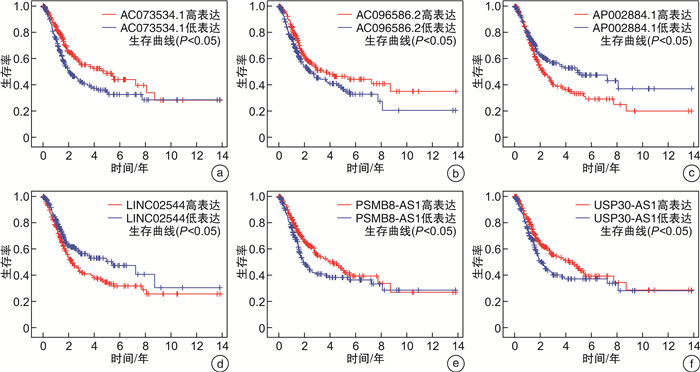
 下载:
下载:
